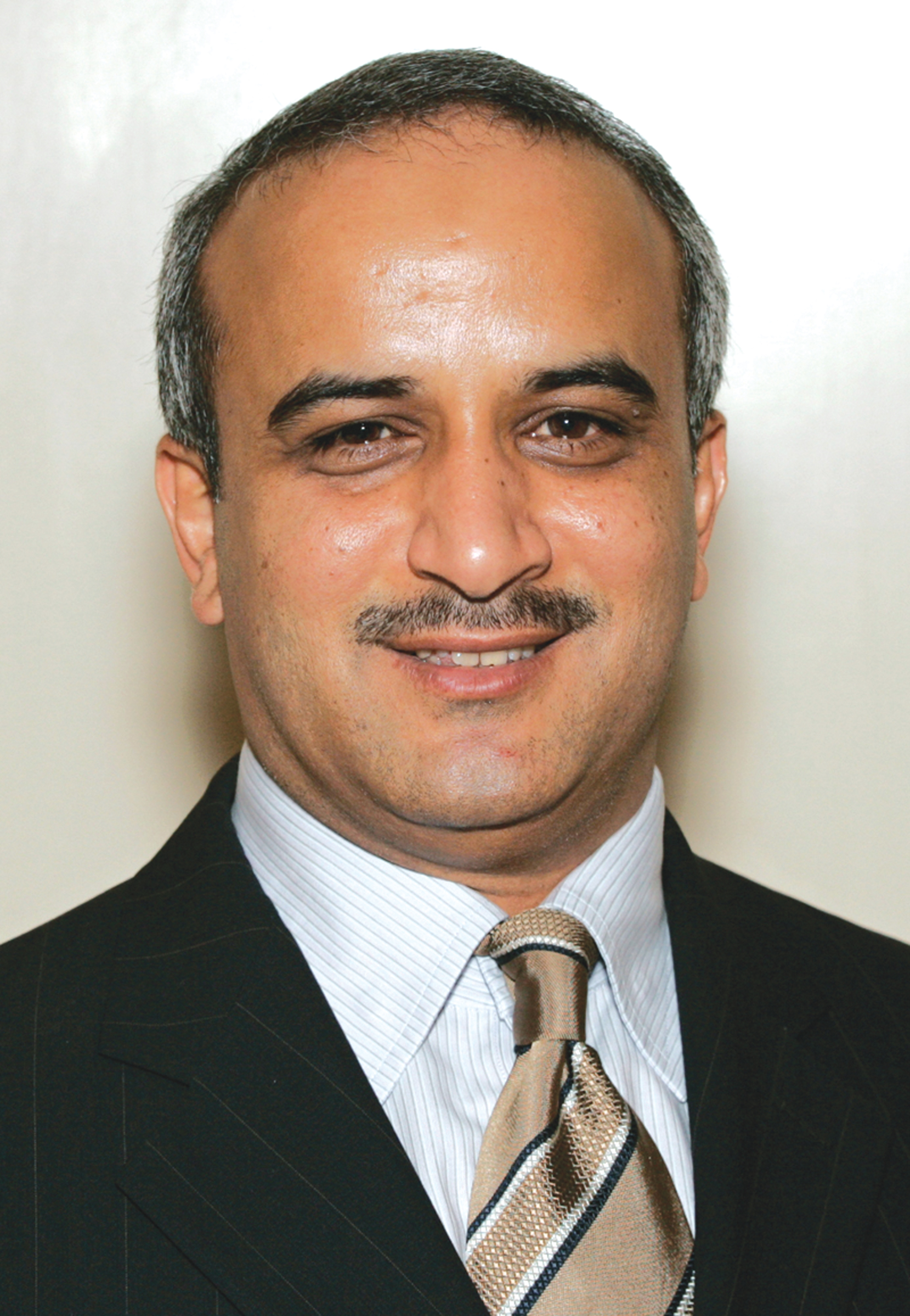By S. Clayton Moore
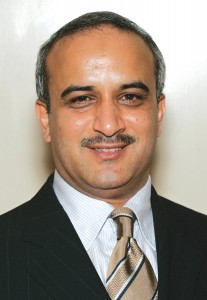
Emirati Ghaith Saeed Khalaf Al Ghaith has been with Emirates Airlines for nearly 20 years and has become a familiar face in the United Arab Emirates business community.
Business is booming in the Middle East. At the heart of both the tourism and business sectors of the United Arab Emirates is its official air carrier, Emirates Airlines.
One of the fastest growing airlines in the world, it has received more than 250 international awards for excellence. No other carrier in the commercial aviation world is growing like this company, which has seen record profits in the last year. Last year, the airline showed more than $637 million in profits, for a nearly 49 percent increase. Its fleet carried 12.5 million passengers, 2.1 billion more than the previous financial year.
The Dubai-based airline has come a long way since it was launched on Oct. 25, 1985. Initially flying with just two aircraft—a Boeing 737 and an Airbus 300 B4, both leased—the company has experienced explosive growth, doubling in size every four years since it commenced operations. Today, the Emirates Group of companies encompasses its award-winning airline with a fleet of 71 aircraft, an international cargo division, a fully operational destination management and leisure division, a ground handler and an airline IT developer.
“It has been very exciting,” said Ghaith Saeed Khalaf Al Ghaith, executive vice president of commercial operations worldwide.
He’s been with the airline, his first and only employer, for nearly 20 years now. After earning a bachelor of science degree at the University of Arizona, he started as a trainee with Emirates Airlines in 1986. Al Ghaith was quickly promoted to deputy sales manager before moving up to head the London office and finally to manage commercial operations in 1995.
“I’ve really grown with the company. I didn’t know anything about the airline business and then gained much more knowledge through airline operations,” he said. “Ten years ago, if you had asked me if I believed I would be here today, having achieved so much and having seen the airline go so far, my answer would have been no. We have to be truthful with ourselves and we really have become more successful than I would have ever believed.”
The last two years has brought even more challenges to Emirates’ escalating operations. On June 1, 2004, it inaugurated non-stop service from Dubai to New York, a small inroad into the vast American market on which the airline hopes to build.
It made an even bigger wave at the Paris Air Show in June 2003, when it announced the largest aircraft order in aviation history, worth at the time over $19 billion in U.S. dollars. The move added 71 new jets, a mix of Boeing aircraft and the latest ultra-modern aircraft from Airbus, including its lauded A380 double-decker super jumbo jet and the new A340-600.
Welcome to Dubai
Nothing has more influence on Emirates Airlines than its home base of Dubai, the most vibrant city in the Gulf region. In all the Middle East, there is no place quite like it. Described by some travelers as the Hong Kong of the region, it was originally a desert trading post home to just 5,000 people. Things have changed.
In a smart attempt to diversify the country’s assets away from oil, it has developed into one of the hemisphere’s premier tourist destinations with seven-star luxury hotels along the Dubai creek that forms the heart of the city. Resembling the people of the airline itself, residents of Dubai hail from over 150 nationalities. Tourists flock from all over the world to enjoy attractions like the wave-shaped Jurmeirah Beach Hotel and to shop for silks, gold and spices in the city’s bazaars.
“We’re very fortunate that our home base in Dubai is so dynamic and has been able not only to develop itself as a tourist destination but as a hub for all kinds of services,” Al Ghaith said. “The government has invested a lot of money in tourism and building first-class infrastructure to attract all kinds of businesses.”
The airport in Dubai is undergoing a revolutionary $4 billion expansion with the expressed intent of increasing the airport’s capacity to 70 million passengers per year by 2012. Emirates is working with its government to position Dubai as a hub to not only draw visitors to the city of gold but also to funnel a large percentage of the region’s air travel through it.
“Coping with growth is our biggest challenge,” Al Ghaith observed. “Just moving into the airport and continuing our operations at the same time is a massive undertaking. The current airport has a capacity of maybe 30 million and it will run out of room in the next year or two. It will come just in time for us to be able to manage our own growth.”
The crown jewels
Emirates is tied directly to the state not just because of its partnership in the airport project, but also because the airline is wholly owned by the government of Dubai and tied closely to the royal family through its chairman, His Highness Sheikh Ahmed bin Saeed Al-Maktoum, the younger brother of the late ruler of Dubai.
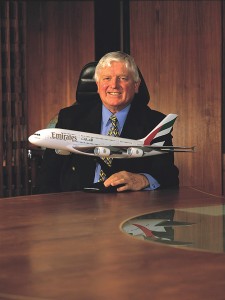
Emirates Group President Maurice Flanagan has helped the company minimize its cost and boost profits to more than $708 million in the past year.
The airline has had to field some criticism from competitors such as British Airways and Air France, both of whom have leveled unconfirmed charges that its massive expansion is being unfairly subsidized by its owners. However, Emirates continues to insist that it’s financially independent these days and that it’s competition that forces the airline to succeed.
Sheikh Ahmed commented on the controversy earlier this year.
“Since we started the airline in 1985, our competitors seem to find it incomprehensible that we can make profits by having a skillful team that works hard, is a market leader and invests heavily in new equipment—surely the criteria for any successful company?” he asked.
Al Ghaith and President Tim Clark lead the company’s day-to-day operations, under the overall supervision of Emirates Group President Maurice Flanagan, a veteran of British Airways who landed in Dubai in 1978 to run travel services for the government. Seven years later, he was given the once-in-a-lifetime chance to take $10 million and start a new airline in the region. He has built a reputation throughout the industry as a fierce supporter of unprotected competition and often cites Emirates’ success as an example of its benefits.
“Emirates is owned by the government of Dubai, but we receive no subsidies, and got only a prudent input of capital at the beginning,” Flanagan recently said. “We have to be market-driven to survive, winning passengers and cargo customers the old-fashioned way—one at a time. Emirates is run on the principle that customers are smart, recognize and reward better service, and are willing to pay for good value-for-money.”
Flanagan ensures the success of an overall structure that includes not only the airline but also SkyCargo, with revenues of $940 million, and Dnata, a travel services division with revenues of $385 million, as well as several other related services such as Emirates Holidays.
Al Ghaith said that it’s the company’s extraordinary efficiency that is the key to its success.
“Dubai’s open skies policy has helped this airline,” he said. “I think it has helped both staff and management to work very hard to achieve our goals. We’re always on our toes because we have always had to perform at our best, otherwise our government wouldn’t have supported us in the first place. Our efficiency is very important. We utilize our aircraft at high capacity, carry very good load factors and we have a very strong work force.”
The airline has also made conscious efforts to keep red tape and bureaucracy to a minimum, led by the efforts of its robust chairman.
“The sheikh has been involved with the company since day one and he’s involved in all of the decisions regarding the business,” Al Ghaith explained. “Even though he’s a very nice man, it’s his strength that has helped us to get where we are.”
He said one of the key aspects of Emirates is the ability to make decisions very quickly.
“Decisions don’t take months or weeks or days; they take seconds, especially when the background work has been done,” he said. “We have a meeting with the sheikh every week and most of the decisions are made there. We don’t go through government types of presentation or filing of plans or waiting for decisions from a hierarchy of ministries. Our decisions are approved around the table and their speed has done a lot to influence our success.”
Flying high
The airline started flying to eight new destinations in 2004 alone and now flies to 78 cities in 55 countries.
“We’re developing east and west,” Al Ghaith said. “We have gone as far east as Australia and are flying to New York in America. We started with Africa a long time ago, but there are more and more countries that are expanding as destinations particularly in the north side of the continent. We’re putting more roots into the countries of the former Soviet Union. We believe those countries have lots of potential for connections to Dubai because it’s a great place to transit to other places and there’s a lot of potential for services to be exchanged between countries. We’re making a lot of effort to develop that economic relationship.”
The airline also plans to expand its services into the United States, although plans to fly into the West Coast were put on hold when oil prices started inching up towards 50 dollars a barrel.
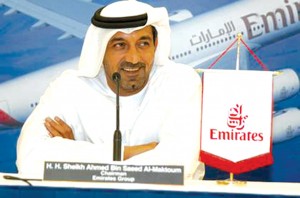
Emirates Airlines is wholly owned by the government of Dubai and tied closely to the royal family through its chairman, His Highness Sheikh Ahmed bin Saeed Al-Maktoum, the younger brother of the late ruler of Dubai.
“I think we’re still good for that plan,” Al Ghaith confirmed. “Our next plans for expansion will be announced at the end of this year, but we’ll probably have a second flight into New York City as well as a city on the West Coast. We’re very keen on San Francisco.”
Emirates has worked hard to maintain the bottom line, including such radical steps as a hiring freeze on all personnel except for flight deck, cabin crew and engineering staff. Their efforts have certainly paid off. The parent company, Emirates Group, announced in late April that it had achieved record-breaking profits of $708 million for the financial year ending March 31, a 49 percent boost over the previous year.
The airline’s revenues totaled $4.9 billion for the year. Its government owners will see the benefits as well when Emirates pays an increased dividend of $100 million to the government of Dubai. The owners have received $291 billion from the airline since dividends started being paid in 1999.
A first-class Fleet
One of the primary ways Emirates will be handling its strong growth is with a first-class fleet of aircraft. With the addition of nine new aircraft last year, Emirates’ fleet stands at 76, including 70 passenger aircraft and six freighters.
Another factor that separates the airline from its competitors is the remarkable youth of its fleet. The median age of an Emirates aircraft is just four and a half years—more than eight years younger than the industry average of 13 years.
More importantly, the fleet will remain fresh with the massive expansion cycle already underway. Emirates is constructing a new $353 million engineering center on a 136-acre site to keep pace with the growth of its fleet. When completed, the new center will be one of the largest civil aviation facilities in the world, with eight hangars forming the largest free-spanned structure in the Middle East.
The first two of 30 Boeing 777-300ERs ordered by the company arrived in late March. These aircraft, added to the 45 new Airbus 380 super jumbo jets ordered last year—the largest order by far—and 28 of Airbus’ ultra-long range Airbus 340-series, mean that Emirates will see wide-body aircraft being delivered at an average rate of one per month for the next eight years. Emirates plans to use their 380s to serve the world’s busiest airports, where landing slots are at a premium, including London’s Heathrow Airport as well as Dubai.
Al-Maktoum also visited Boeing in March for further talks about the planned 787 jetliner and 777-200LR, which the airline has under consideration, as well as the Airbus 350.
“These are all excellent aircraft and we believe they will give us two competitive advantages,” Al Ghaith said of the current aircraft order. “First, they will reduce cost, but more importantly they will give us a better product and make us a better airline. The 340 has already been tested and we’re getting a lot of mileage out of it for our premium passengers. We’ve been getting a lot of good reviews and we believe the 340 is second-to-none. We’re also looking forward to the 380s because they’ll be a very luxurious and sophisticated way to travel.”
It’s been an interesting approach for the airline to favor luxury in an era when other commercial airlines are struggling to make ends meet. Since its founding, it has deliberately marketed itself to high-end travelers and competes for service and amenities with other top-level competitors like Singapore, Cathay Pacific and British Airways.
The current round-trip fare for a first-class seat between New York and Dubai may run almost $10,000, but passengers get a lot of comfort for their cash. That seat is in fact a fully enclosed suite with a fold-down bed, 19-inch video screens with 150 selections, in-flight email and “room service.” Transit passengers can enjoy a complimentary massage and health club services at the Marhaba Lounge in Dubai. The new Airbus 380s will even be outfitted with cabins that include a shower.
It’s those attractions, the company says, that is helping it to run at an impressive 74.6 percent capacity and maintain its place among the world’s five most profitable carriers.
An international community
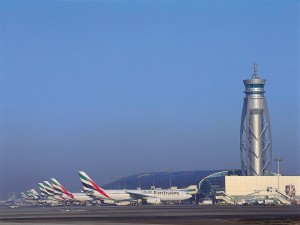
The airline’s fleet of 76 Boeing and Airbus wide body aircraft are housed and maintained at Dubai International Airport (DXB), which is undergoing a $4 billion expansion.
It’s not just amenities that make the difference, according to Al Ghaith. He says the diverse workforce of Emirates Airlines makes a real difference to passengers. From friendly and professional customer service agents to its striking flight attendants, Emirates works to maintain its youthful image and its strong international base of employees.
“We have over 100 different nationalities working for us,” he said. “It’s that mix of people from all over the world that has helped Emirates become the truly international airline that it is. We’ve pulled the best talent from all over the world and most of them are living and producing their best work in Dubai with ultimate freedom. They’re very comfortable living here and we’re very blessed to have them. They make the difference.”
The Emirates Group currently employs more than 25,000 people from 124 countries. The airline employs 5,600 cabin crew from more than 100 nations and 1,135 captains and first officers from 60 nations, nearly 100 of them Emirati nationals. Last year, the company received 240,000 job applications.
In some respects, the airline is a reflection of Dubai itself—a broadminded, multicultural oasis with English as the common language.
“Dubai is the most international place you will ever visit,” Al Ghaith said. “As Emerati, we are extremely open-minded. We don’t think of ourselves as unique or separate from other countries. It’s a country that attracts people from other countries to add value to our own nation. When you travel with most airlines, they all look the same. When you travel with Emirates you get to meet people from all over the world and from every walk of life.”
Facing the future
It would seem that a company with an economic impact on its home country of $2.75 billion would have no worries, but like its competitors, the high cost of fuel is causing some concerns at Emirates Airlines.
“If fuel prices reach $60 and $70 per barrel, many airlines will suffer,” Al Ghaith admits.
Although the airline has been aggressive in negotiating fuel prices, he believes that governments around the world should do more.
“Fuel prices are challenging and it’s something that we’re trying to do something about,” he said. “The airlines are ruled over by many governments who rule on what to charge or not to charge for fuel. A good price policy that is fair and equal in all markets is just not there unfortunately. For example, we would like to see the fuel surcharge change when the price goes up or down so that the passenger is charged effectively according to what the fuel costs the airline through some kind of fair methodology.”
However, Al Ghaith is confident that the airline’s successful combination of Arab hospitality and 21st century technology will continue to build up the company into an aviation powerhouse.
“This is where our confidence for the future comes in. If we continue to work hard on the fundamentals that helped to get us here, we will no doubt be successful in the future,” Al Ghaith affirmed.
For more information, visit [http://www.emirates.com].











